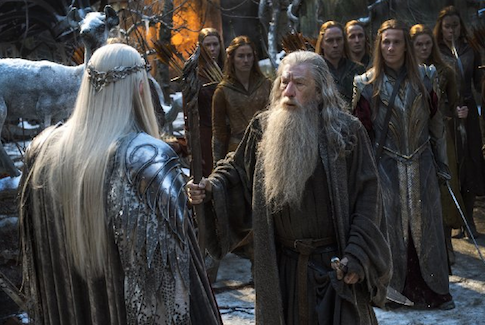There’s a lesson for filmmakers in the fact that Peter Jackson’s best foray into Middle Earth was also his smallest.
The Fellowship of the Ring introduced filmgoers to hobbits and the shire, elves and Rivendell, wizards and balrogs. But it did so on a smaller scale than that of later films, focusing on the journey of a few protagonists. Ironically, restricting the characters and locales magnified the sense of drama, and heightened the tension. We actually cared about what happened to the fellowship.
As the films grew in scope and grandeur, as makeup and models were replaced by pixels, that sense of precariousness (preciousness?) was lost. The climactic battles in Return of the King involved, first, a computer-generated horde of ghosts swarming a computer-generated horde of orcs, and then a computer-generated horde of orcs being swallowed by a computer-generated earthquake.
Jackson has ignored the lessons he should have learned from making The Lord of the Rings. His Hobbit flicks are comically overstuffed, a seven-hour epic drawn from the shortest of Tolkien’s Middle Earth books and filled with plotlines that appeared nowhere in the original text. With Battle of the Five Armies, the series culminates in a multi-hour depiction of violence that in the novel takes up just a few pages.
Many have likened the action of this battle to a video game cut scene—the portions of a game in which there is no actual gameplay, just animation revealing a piece of the plot or a bit of adventure taking place elsewhere. This is both accurate and overly generous. At least most cut scenes are a minute or two in length.
For nearly two-and-a-half interminable hours, The Battle of the Five Armies throws waves of computer-generated elves and computer-generated dwarves against computer-generated orcs. It’s a relief when the computer-generated eagles swoop in to save the computer-generated day.
You’ll notice that I haven’t discussed the plot. That is because there is so little of it. We open as the dragon Smaug begins his devastation of Lake-town. The dragon is quickly defeated, but not before destroying the hamlet and causing the villagers to flee to the mountain claimed by the dwarves in the previous film.
Thorin Oakenshield (Richard Armitage), the dwarf king, has been driven mad by the gold hoard he took from Smaug, a fact we are reminded of, repeatedly, for the first 90 minutes or so.
Then some elves show up to get some diamonds out of the mountain, and it looks like all the good guys are going to fight, and then the orcs show up, and the good guys team up with the bad guys, and it’s all SCRASH! and SCHRAW! and SCROOSH! for the next (and final) 100 minutes.
Which brings me back to Fellowship. The single greatest moment in all six of Peter Jackson’s Rings films comes near the end of that picture. An elf and a man fight off a horde of orcs, then hear a horn. One of their allies is in trouble. They run down a hill to aid him, and the camera tracks ahead, then up into the trees, allowing us to see what lies between them and their friend. Their enemies are tangible, not computer generated, and not-at-all countless.
That sense of finitude lends the scene immediacy. So when orc arrows kill Boromir, who had given in to the One Ring, the loss is terrible. And when Boromir asks Aragorn if Frodo is safe, confessing his momentary lapse of control, a tear wells in your eye. And when the two confide their fears about the future of the West, we see the plight of their people reflected in their eyes.
Boromir’s sacrifice is real. Far more real, indeed, than anything in The Hobbit: The Battle of the Five Armies. And that is why Fellowship endures, as the rest of these films, like ring-wraiths, fade away.
